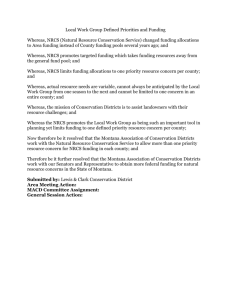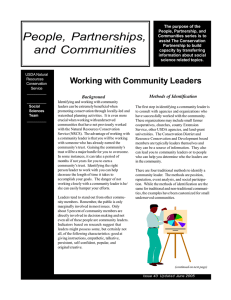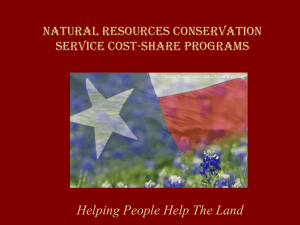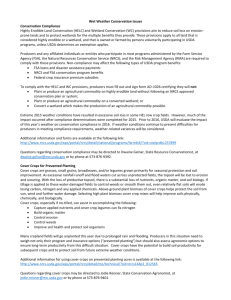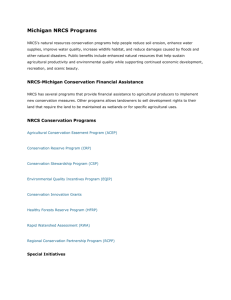C E A P
advertisement
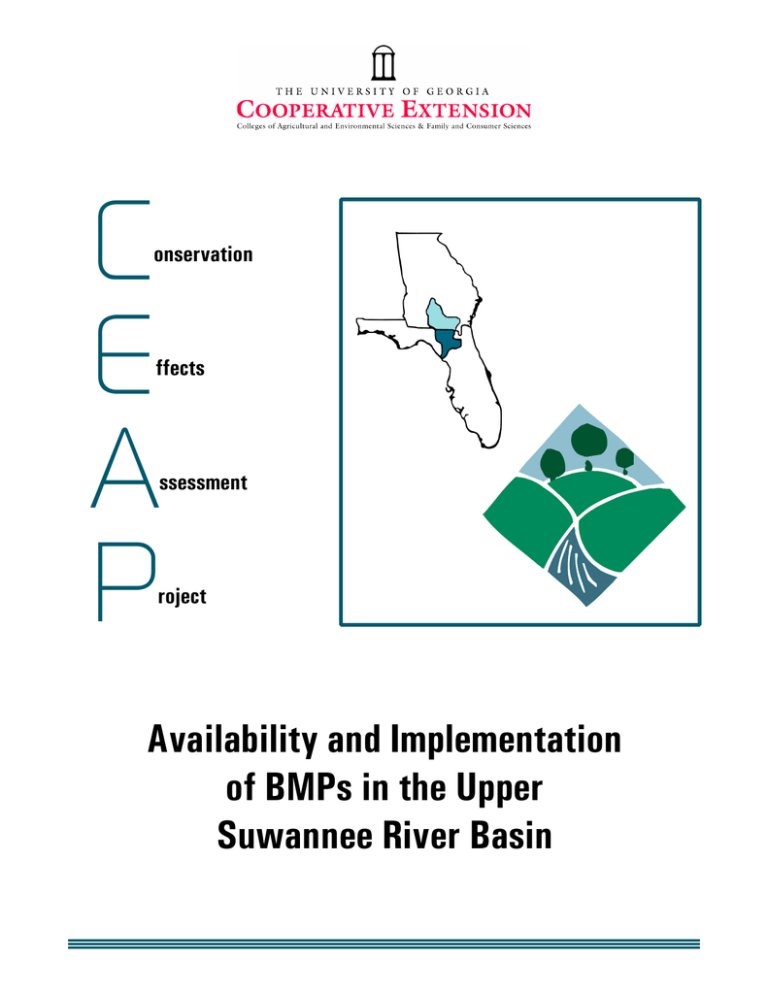
C E A P onservation ffects ssessment roject Availability and Implementation of BMPs in the Upper Suwannee River Basin Table of Contents What Is CEAP and Conservation? . . . . . . . . . . . . . . . . . . . . . . . . . . . . . . . . . . . . . 3 What Are Best Management Practices? . . . . . . . . . . . . . . . . . . . . . . . . . . . . . . . . . 3 How Do BMPs Help the Environment? . . . . . . . . . . . . . . . . . . . . . . . . . . . . . . . . . 3 Agencies that Offer Assistance . . . . . . . . . . . . . . . . . . . . . . . . . . . . . . . . . . . . . . . 4 Summary . . . . . . . . . . . . . . . . . . . . . . . . . . . . . . . . . . . . . . . . . . . . . . . . . . . . . . . . 5 Acknowledgments . . . . . . . . . . . . . . . . . . . . . . . . . . . . . . . . . . . . . . . . . . . . . . . . . 5 Available Programs . . . . . . . . . . . . . . . . . . . . . . . . . . . . . . . . . . . . . . . . . . . . . . . . 6 CEAP: Availability and Implementation of BMPs in The Upper Suwannee River Basin Gary L. Hawkins, Ph.D., Extension Specialist – Pollution Prevention Department of Biological and Agricultural Engineering Rebekah Wallace, Student University of Georgia What Is CEAP and Conservation? tions can vary widely from field to field. Best management practices are typically used in agricultural areas, forests and urban settings. Agricultural BMPs (Figure 1a, 1b and 1c) are typically used on production fields, in livestock operations and in urban settings to reduce runoff, reduce erosion, increase infiltration and reduce usage of pesticides. These practices may also include measures to reduce the potential spread of chemicals from containment areas. Other agricultural BMPs may consist of limiting cattle access to streams or providing high use watering areas. The use of bioretention ponds or areas in urban settings provides an attractive way to control erosion and runoff, and increase infiltration. Forest/Wildlife Habitat BMPs (Figure 1d) are typically used in forest settings or in forest areas adjacent to agricultural fields to reduce runoff to and sedimentation in streams and to increase wildlife populations. Some of these practices may include site preparation, reforesting plans, harvesting operations, habitat restoration, ground cover/brush implementation, wildfire management, and food/water source management. Riparian Zone BMPs can include buffer zone restoration, erosion control and habitat restoration. While the individual plans can be different, they all lead toward the same goal: improving and conserving the surrounding environment for people as well as wildlife. Conservation Effects Assessment Project (CEAP) began in 2003 through the cooperation of multiple agencies, including Natural Resource Conservation Service, Farm Service Agency, Agricultural Research Service, and Soil and Water Conservation Society to name a few. The goal of the project was to quantify the environmental benefits gained from private landowners implementing conservation practices in certain USDA Programs. There are three components under CEAP: (1) National Assessment, (2) Watershed Assessment Studies, and (3) Bibliography and Literature Reviews. The National Assessment determines how well USDA programs meet the nation’s conservation and environmental goals and the benefits of conservation practices. Areas being reviewed are croplands, wetlands, wildlife and grazing lands. The Watershed Assessment Study will evaluate conservation practices in selected watersheds across the nation which will provide an outline for assessing and improving national assessment models. The Bibliography and Literature Reviews document what is known and unknown about current environmental practice benefits and what programs are offered for cropland and fish and wildlife. What Are Best Management Practices? Best Management Practices (BMPs) can be described as management practices and/or structural practices that are designed to reduce the amount of pollutants and erosion while increasing the quality of all life. The BMP concept deals specifically with non-point source pollution, such as runoff from agricultural fields, forest areas or urban areas. Best management practices are also voluntary in nature. The individual practices and applica- How Do BMPs Help the Environment? Best management practice implementation aids the earth’s natural life support system. A plan that includes practices to control erosion leads to: longer useful soil life, better habitat for soil organisms, cleaner surface waters and topsoil conservation. Water quality plans may include practices that account for nonpoint source pollu3 (a) (b) (c) (d) Figure 1. Best management practices are structures and practices designed to prevent or reduce water pollution. The four figures above show some practices used in agriculture and forestry: (a) Conservation tillage is an agricultural BMP that reduces erosion and increases filtration (photo by G.L. Hawkins); (b) High traffic watering areas is an agricultural practice that reduces or eliminates the need for cattle to get into streams or bodies of water (photo by G.L. Hawkins); (c) Bioretention areas are urban agriculture practices that make nice areas in a landscape while reducing runoff (photo from VA forestry Web site); (d) Wood crossing is a forestry practice that provides a safe crossing while protecting water quality (photo from Georgia Forestry Commission). improve our natural resources and environment.” Through the use of government cost-share programs and technical assistance programs the agency helps people help themselves. Several of the programs offered include varying degrees of cost-sharing. This benefits the environment, the agency, people already using the programs, as well as anyone who would want to use the programs in the future. Georgia Soil and Water Conservation Commission (GSWCC): GASWCC’s mission is to protect, conserve and improve soil and water quality in Georgia. It differs from NRCS in that it focuses specifically on soil and water quality while NRCS addresses all natural resources. Assistance provided from GSWCC consists of cost-share funds for improving irrigation efficiency, collecting and storing irrigation water, improving wildlife habitat, and improving urban soil and water management. Georgia Forestry Commission (GFC): The Georgia Forestry Commission provides leadership, service, and education in the protection and conservation of Georgia’s forest resources. Their main goal is to maintain a healthy, sustainable forest that provides clean air, clean water, and abundant products for the future. The GFC provides information on the use of conservation easements and forestry related grants. USDA-Farm Service Agency (FSA): FSA’s vision statement is “A customer-driven agency with a diverse and multi-talented work force, dedicated to achieving an economically and environmentally sound future for American Agriculture.” Whereas some of the other agencies aim toward the environment and environmental landmarks, FSA is more concerned with people. The agency ensures the well-being of U.S. agriculture through efficient and equitable administration of farm commodity programs, conservation and environmental programs, emergency and disaster assistance, domestic tants, point source pollutants, ground and surface water testing, and aquatic habitat restoration. Air quality plans may include practices such as tighter restrictions for particulate waste from industry factories, noise buffers, wind erosion control and emissions standards for automobiles. Agencies that Offer Assistance Many BMPs are voluntary at the moment. It may not be long before they are no longer voluntary and become mandatory. To help implement BMPs, many agencies have a variety of programs available to assist farmers and stakeholders in determining which practices best fit their specific needs. Several programs offer some kind of financial assistance, usually in the way of a cost-share percentage. Many programs offer technical assistance in which the agency or entity offering the program will help the individual set up the BMP plan. Within the Upper Suwannee River Basin, agencies offering help to farmers and stakeholders include University of Georgia Cooperative Extension (UGA EXT), USDA Natural Resources Conservation Service (NRCS), Georgia Soil and Water Conservation Commission (GASWCC), Georgia Department of Natural Resources (DNR), and the United States Department of AgricultureFarm Service Agency (USDA-FSA). While it may seem that a lot of these agencies are all doing the same things, they each have different responsibilities regarding conservation. A majority of the programs that provide funding for implementation of BMPs for the purpose of conserving natural resources can be found in Table 1 at the end of this publication. Natural Resource Conservation Service (NRCS): The NRCS mission statement is “The Natural Resources Conservation Service provides leadership in a partnership effort to help people conserve, maintain, and 4 (b) (a) Figure 2. Best management implementation promotes (a) improved and diverse soil micro and macro biology (picture taken from Soil Biology Primer, published by SWCS in cooperation with USDA-NRCS), and (b) improved water and air quality (photo taken by USDA-NRCS). give them a call at 1-800-ASK-UGA1. This number will direct your call to your local UGA Cooperative Extension Office. and international food assistance, and international export credit programs. These programs are part of USDA’s farm safety net, which helps maintain viable operations, compete for export sales of commodities, and contributes to year-round availability of low-cost, safe and nutritious foods. The FSA offers assistance through these listed cost-share programs specifically dealing with long-term and emergency farmland conservation. Georgia Department of Natural Resources (GADNR): The Georgia DNR centers on natural resources as well as cultural and historic resources. They promote areas of the state that have significant historical and cultural value, while also protecting and supporting state parks and archeological areas. To assist citizens with various aspects of protecting natural resources, the GADNR is divided into seven topic-specific divisions. These divisions are Coastal Resources; Environmental Protection; Historic Preservation; Parks, Recreation, and Historic Sites; Pollution Prevention Assistance; Program Support; and Wildlife Resources Divisions. Funds available from the divisions of the DNR are specific to that division and may consist of technical or financial assistance. The information in Table 1 does not include all Divisions of GADNR since most funds are variable, so if you have specific questions, contact GADNR. University of Georgia Extension (UGA EXT): The UGA Cooperative Extension does not provide monetary assistance to farmers and stakeholders, but instead provides science-based information on various BMP practices. The UGA EXT can work with farmers and other agencies to determine what potential sciencebased options are available. For more information on how the UGA Cooperative Extension can assist you, Summary BMPs are valuable tools used on a voluntary basis by farmers and stakeholders to improve the environmental and personal quality of the land they own. Within the Suwannee River Basin, there are many programs available to assist farmers and stakeholders in planning for and implementing BMPs. If you have any questions or need assistance with any of the listed programs contact the appropriate person or see your local UGA Cooperative Extension Agent. Acknowledgements It is only with the help of many people within each of the state agencies — Georgia Department of Natural Resources, Georgia Natural Resource Conservation Service, Farm Service Agency, and Georgia Soil and Water Conservation Commission — that this publication could be assembled. For more information on each agency, refer to their individual websites: NRCS – http://www.nrcs.usda.gov Georgia DNR – http://www.gadnr.org, and http://www.AgP2.org FSA/USDA – http://www.fsa.usda.gov GASWCC – http://gaswcc.georgia.gov For more detailed information on the Conservation Effects Assessment Project, please see http://www.nrcs. usda.gov/technical/nri/ceap/. 5 6 Description Conservation of Private Grazing Land Description Conservation Innovation Grants Title of Program Range of Funds Sign-up date Contact Information Dependant upon competition Generally in Spring GA NRCS ASTC Programs (706) 546-2083 No state competitions for Georgia, Grant Based Program. Comments Technical Assistance N/A Generally in Spring GA NRCS State Grazing Specialist (706) 546-2115 Intended to arouse the interest and adoption of new technology and approaches to conservation of the environment. Will aid states to become compliant to governmental regulations regarding the environment. Website: http://www.nrcs.usda.gov/programs/cig/ Financial Assistance Natural Resource Conservation Service (NRCS) Financial Assistance/ Technical Assistance Provides opportunities for better use of resources, more plants to sequester greenhouse gases, more efficient ways to produce food and fiber, raw materials for industrial processes, protection from erosion, habitat rebuilding for wildlife, and other positive natural resources. Rewards farmers who are doing a high degree of conservation on their farms that provides benefits to all of society through improved soil, water and air quality. Website: http://www.nrcs.usda.gov/programs/cpgl/ CPGL CIG Acronym Table 1. Information about agencies and organizations associated with conserving natural resources and programs offered by that agency or organization. The following table provides information on programs available within the Upper Suwannee River Basin. The listed programs are divided by agency. The information provided includes program name, acronym, assistance type, funding ranges, sign-up date, contact information, and any specific comments. Some of the terms in the table include: Cost-share — A portion of the cost of the project or program is paid for by a party other than the sponsor. It is usually described in percentages, i.e., 50 percent cost-share, 75 percent cost-share. Technical Assistance — Help provided through education of a new technology, planning, plan implementation, assessment of plan effectiveness, and any other means of assistance without providing funds. N/A — Not Applicable Available Programs 7 Announced on Federal Register Notice GA NRCS ASTC Programs (706) 546-2083 Contact Information Eligible Watersheds change every year. Comments N/A GA NRCS ASTC Operations (706) 546-2097 Financial Assistance/Technical Assistance Dependant upon individual lands Within 60 days of a disaster GA Water Resources Team Leader (706) 546-2073 Program available after natural disasters, selling watershed land. Description Grassland Reserve Program Financial Assistance/ Technical Assistance Dependant upon individual lands Dependant upon individual lands Continuous Sign-up GA NRCS ASTC Programs (706) 546-2083 GA NRCS ASTC Programs (706) 546-2083 Landowner cannot make requests for themselves, must be made by a sponsor. Offers the chance for landowners to protect, restore and enhance their grasslands. Program is designed to conserve vulnerable grassland from being converted to cropland as well as protecting the grassland to ensure future ranching viability. Website: http://www.nrcs.usda.gov/programs/GRP/ GRP Financial Assistance Landowner must work with a local, state or private sponsor that works with farm land protection. Many qualifications to meet before being considered for financial assistance: conservation plan for highly erodable land, privately owned, accessible to the markets they sell to, large enough to sustain agricultural production, enough land to support a long-term agricultural production, and an adequate infrastructure and agricultural support services. Website: http://www.nrcs.usda.gov/programs/frpp/ Two to ten year contracts. Description GA NRCS ASTC Programs (706) 546-2083 Determined by NRCS National Office Continuous Sign-up FRPP Average $15,000 – $16,000 Farm and Ranch Land Protection Program Financial Assistance/Technical Assistance Provides assistance to farmers to address soil, water and other natural resource concerns on their land in an environmentally beneficial and cost-effective manner. Use of conservation plans include structural, vegetative and land management practices to achieve the conservation goals. Website: http://www.ga.nrcs.usda.gov/programs/eqip06.html EQIP To take on emergency measures to retard water run-off and slow or prevent soil erosion in an effort to save lives and property from fire, flood, and erosion damage when a natural event has caused an impairment of a natural watershed area. Website: http://www.nrcs.usda.gov/programs/ewp/ EWP Provides assistance to help people conserve, maintain and improve their environment. Helps people plan and implement conservation on their land. Website: http://www.nrcs.usda.gov/programs/cta/ Technical Assistance Description Environmental Quality Incentives Program Description Emergency Watershed Protection Description CTA Determined by local office Follows Tier System Sign-up date Conservation Technical Assistance Financial Assistance/Technical Assistance Range of Funds Promotes the conservation and improvement of soil, water, air, energy, and plant and animal life. Includes cropland, improved pasture, grassland, prairie land, range land, and forested land that is part of an agricultural operation. Website: http://www.nrcs.usda.gov/programs/csp/ CSP Conservation Security Program Financial Assistance/ Technical Assistance Description Acronym Title of Program 8 Description Wildlife Incentives for Non-Game and Game Species Description Wildlife Habitat Incentives Program Description Wetlands Reserve Program Description Plant Materials Program $50,000 - 500,000 Range of Funds Generally in Spring Sign-up date GA NRCS State Grazing Specialist (706) 546-2115 Contact Information Comments N/A N/A Plant Materials Specialist, Team Leader (706) 546-2115 Depends on Program Type Continuous Sign-up GA NRCS State Biologist (706) 546-2309 Dependant upon individual lands Continuous Sign-up GA NRCS State Biologist (706) 546-2309 Signed agreements last between five and ten years. Financial Assistance/Technical Assistance $50 per acre per year over three years Generally in Spring GA NRCS State Biologist (706) 546-2309 Up to $1,500 per contract, May reapply three years after last contract has expired. Incentives are provided to improve fish and wildlife habitat, most notably the bobwhite quail habitat. A highly effective program for participants who are ineligible for other government funded programs. Website: http://www.nrcs.usda.gov/programs/whip/ Financial Assistance/Technical Assistance Financial incentives used to protect, restore, and enhance wetlands on the property emphasizing the habitat of migratory birds. A main goal of the programs is that long-term wildlife conservation and protection are established. Three types of programs: Restoration Cost-Share Agreement, 30 year Easement, and a Permanent Easement. Website: http://www.nrcs.usda.gov/programs/wrp/ Financial Assistance/Technical Assistance Using native plant materials to address the conservation needs of an area. Plant material would be used for carbon sequestration, biomass, erosion reduction, improvement of water quality, etc. Website: http://www.ga.nrcs.usda.gov/programs/pmprog.html Technical Assistance Seeks to maintain, restore and improve the management and productivity of the Nation's privately owned grazing lands. Website: http://www.nrcs.usda.gov/programs/glci/ Financial Assistance Financial Assistance/ Technical Assistance A partnership between several electrical and gas companies and the NRCS. The individual or group committed to the “right-of-way,” a corridor where gas and power lines pass through, will be responsible to its upkeep and must follow through on a program that they choose with the local NRCS office. Website: www.tworiversrcd.org WINGS WHIP WRP PMP GLCI Grazing Lands Conservation Initiative Description Acronym Title of Program 9 Description Partners For Wildlife Description Irrigation Uniformity (Mobile Irrigation Lab) Description Conservation of Ag Water Supplies Description Agricultural Water Catchment Program Description Ag Lands Title of Program Range of Funds Sign-up date Contact Information N/A N/A Rural Program Man. 706-542-3065 75% cost share, up to $50,000 Sign-up during July SW Regional Representative 229-995-6001 Financial Assistance N/A N/A SW Regional Representative 229-995-6001 Provides irrigators incentives to construct catchments for the purpose of collecting run-off and rainfall for irrigation uses thus reducing the stress on the Floridian Aquifer. Website: http://gaswcc.georgia.gov Financial Assistance GASWCC: Conserving soli and water resources through the use of Best Management Practices as well as decreased pesticide runoff from agricultural productions. Website: http://gaswcc.georgia.gov Technical Assistance Georgia Soil and Water Conservation Commission (GASWCC) Financial Assistance/ Technical Assistance Comments Financial Assistance $3,000 - 5,000 Sign-up during July Division Director 229-995-6001 90% cost share Continuous Sign-up SW Regional Representative 229-995-6001 Assistance from $5,000-10,00015,000 for buffers and up to $20,000 for stream stabilization. Program that provides financial assistance for establishing riparian buffers and stream bank stabilization. Website: http://gaswcc.georgia.gov Financial Assistance Conducts center pivot evaluations to determine eligibility, a score of 70% or lower makes them eligible to receive a 75% cost share assistance to replace pivot nozzles up to $5,000. If greater than ½ acre or applying irrigation to a public road then eligible for 75% cost share assistance up to $3,000 to install end-gun shut off technology. Website: http://gaswcc.georgia.gov PFW MIL Conserving ground and surface waters through quantifying water usage, reducing dependence on ground and surface waters, performing irrigation audits and applying the use of agricultural water catchments. Works to increase the uniformity and efficiency of irrigation systems. Website: http://gaswcc.georgia.gov Water Metering Program Pond Program Acronym 10 Technical Assistance Financial Assistance/ Technical Assistance N/A Range of Funds N/A Sign-up date Program Manager Contact Information Comments Georgia Forestry Commission (GFC) To improve and protect Georgia’s urban soil and water resources using best management practices (BMPs) in the soil and water conservation districts. Also to reduce erosion, sedimentation, as well as educating land disruptors, local governments, conservationists on urban BMPs. Website: http://gaswcc.georgia.gov Acronym Description Farmable Wetlands Program Description Emergency Conservation Program Description Conservation Reserve Program Financial Assistance Continuous Sign-up FSA Survey AG Program Specialist (706) 546-2256 Sign-up period is announced. FWP ECP Cost-share assistance up to 75% Clark Weaver, FSA Supvy AG Program Specialist (706) 546-2256 clark.weaver@ga.usda.gov Conservation issues prior to environmental disaster may be ineligible. Continuous Sign-up Clark Weaver, FSA Supvy AG Program Specialist (706) 546-2256 clark.weaver@ga.usda.gov Voluntary program aiming to restore 500,000 acres of farmable wetlands and buffers by improving the areas hydrology and vegetation. Website: http://www.fsa.usda.gov/pas/publications/facts/html/farmwetland04.htm Financial Assistance Dependant upon individual lands Provides emergency assistance to farmland that has incurred damage following a natural disaster and for those who provide water conservation assistance during times of extreme drought. Website: http://www.fsa.usda.gov/pas/publications/facts/html/ecp04.htm Financial Assistance/Technical Assistance Establishing long-term resource conserving covers on areas of farmland that are deemed eligible. Works to conserve topsoil, reduce run-off and sedimentation, protect groundwater, provide a windbreak and a habitat for wildlife. Website: http://www.fsa.usda.gov/dafp/cepd/crp.htm CRP US Department of Agriculture – Farm Service Agency (USDA-FSA) For more detailed information on assistance available from GFC contact County GFC office or the Georgia State office at 1.800.GA.TREES (428-7337) or visit the GFC website at : http://www.gfc.state.ga.us Description Urban Lands Title of Program 11 Financial Assistance/Technical Assistance Aggregate payment not exceeding $100,000 Range of Funds Continuous Sign-up Sign-up date Clark Weaver, FSA Supvy AG Program Specialist (706) 546-2256 clark.weaver@ga.usda.gov Contact Information Comments Georgia Department of Natural Resources (DNR) PFW Coordinator (912) 256-9336 Maximum of $25,000 provided. Continuous Sign-up AgP2 Coordinator (706) 542-9067 Funding for this work was provided by a grant from the USDA-CSREES Integrated Research, Extension, and Education Program (Award No. 2005-51130-02377), by Hatch and State funds allocated to the Georgia Agricultural Experiment Stations, and the Georgia Department of Natural Resources Pollution Prevention Assistance Division. Description N/A Provides assistance to farmers and rural residents on pollution prevention activities for animal production, animal waste issues, cropland management, composting methods, and land application as well as advising them on Best Management Practices. Promotes sustainable agriculture activities and education and distributes Georgia Farm *A* Syst environmental assessments. Website: http://www.AgP2.org Ag P2 Technical Assistance (through UGA Extension Service) AG P2 Program Maximum cost share up to 100% Tommy Bass - Animal Waste Barbara Bellows - Ag Partnership Julia Gaskin - Land Application Gary Hawkins - Row Crop Rose Mary Seymour - Green Industry Financial Assistance/Technical Assistance Description PFW Providing assistance to individuals who wish to enhance the surrounding wildlife and fish habitats, especially for endangered species. The main emphasis in Georgia is: longleaf pine habitat restoration and enhancement (which includes restoration of the understory), stream/riparian habitat restoration, and endangered and threatened species habitat restoration and improvement. Website: http://georgiawildlife.dnr.state.ga.us/ Partners for Fish and Wildlife For more detailed information on potential assistance available from GA DNR contact them at 2 Martin Luther King, Jr. Drive, S. E., Suite 1252 East Tower, Atlanta, GA 30334, (404) 656-3500 or http://www.gadnr.org Description FLEP Forest Land Enhancement Program Financial Assistance/ Technical Assistance Growth enhancement practices are implemented to sustain the long-term productivity of timber and non-timber forest resources to help meet future public demand and provide environmental benefits. Some other objectives are to reduce the risks as well as help restore the damage to forests caused by fire, insects, invasive species, disease, and damaging weather. Website: http://www.fs.fed.us/spf/coop/programs/loa/flep.shtml Acronym Title of Program The University of Georgia and Ft. Valley State University, the U.S. Department of Agriculture and counties of the state cooperating. Cooperative Extension, the University of Georgia College of Agricultural and Environmental Sciences, offers educational programs, assistance and materials to all people without regard to race, color, national origin, age, gender or disability. An Equal Opportunity Employer/Affirmative Action Organization Committed to a Diverse Work Force Bulletin 1335 January, 2008 Issued in furtherance of Cooperative Extension work, Acts of May 8 and June 30, 1914, The University of Georgia College of Agricultural and Environmental Sciences and the U.S. Department of Agriculture cooperating. J. Scott Angle, Dean and Director
